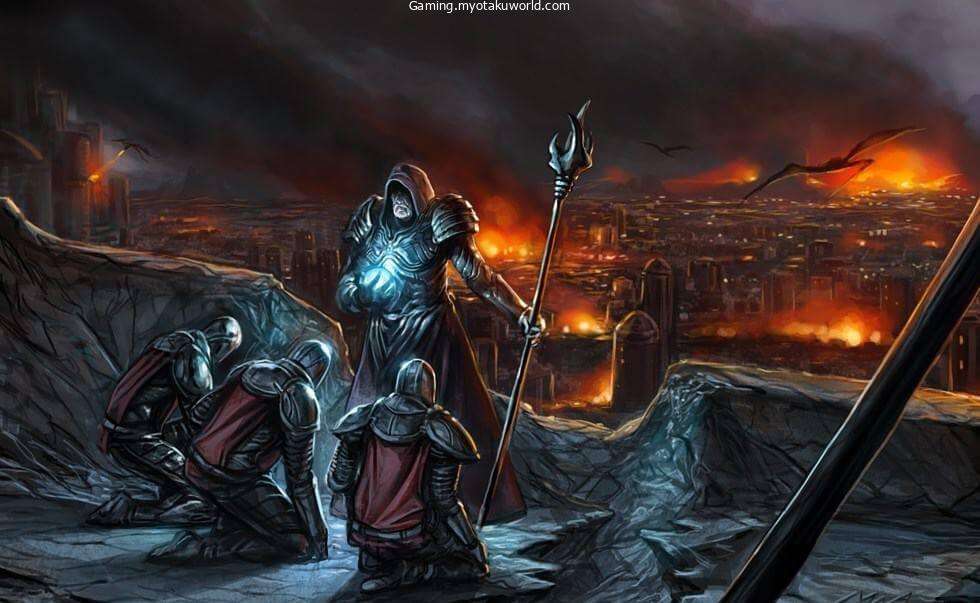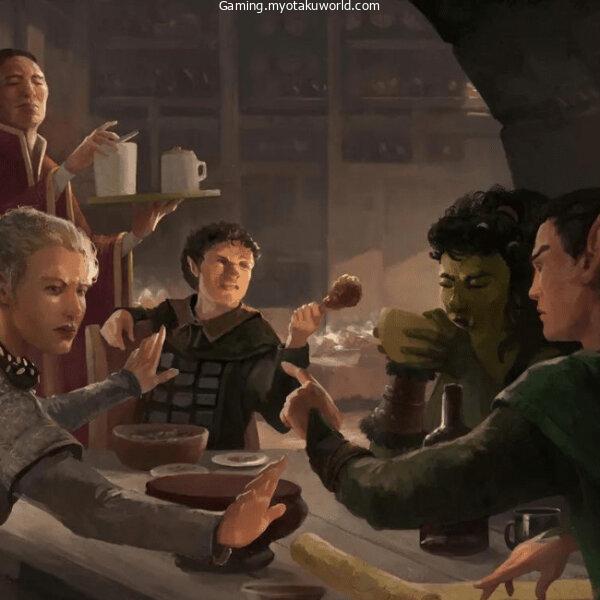Some leaders in the Faerun world and the real world could move mountains with one word. You can also be a leader by using the Command spell.
You can draw danger towards yourself instead of the squishier members of your party, or even make your enemies flee in fear with a single word.
It does have limitations and is not the best spelling. Here is the Command 5e Guide.
What is the Command Spell?
According to the description of the spell in the Player’s Handbook
- 1st level enchantment
- Casting time: 1 Action
- Range: 60 feet
- Components: V
- Duration – 1 round
- Classes: Cleric, Paladin
A command of one word is spoken to any creature that you can see within your range. The target must make a Wisdom saving throw, or it will not follow your command the next turn.
If the target is not alive, if it does not understand your language, or if your command is directly detrimental to its health, then the spell will not work.
Here are some common commands and their effects. You may issue another command than the one listed here.
The GM will decide how the target behaves if you do this. The spell is over if the target doesn’t obey your commands.
- If the target is within 5 feet of you, it will move towards you using the shortest route.
- The target releases whatever it holds and ends its turn.
- The target takes its turn and moves away from you using the fastest possible means.
- The target is then prone and ends its turn.
- The target does not move and doesn’t take any action. If it can, a flying creature will stay aloft. It will fly the distance it needs to stay in the air, even if it has to move.
- Higher Levels: You can cast this spell with a slot of 2nd or higher level. This spell will allow you to affect one more creature for every slot level above 1. When you target them, they must be within 30 yards of each other.
Let’s dissect the spell
It is a 1st-level spell available only to the Paladin Class and Clerics Class. This spell is interesting because when you think about spells, you think of warlocks and wizards.
However, it has more to offer paladins and clerics than simply healing and smiting undead.
It can reach 60 feet. The only vocal component is the command word. The command does not last for one round and is only executed on the affected creature’s turn.
To ward off the effects, the affected creature may make a Wisdom saving throw.
To be affected, the creature must be alive, not dead, and must be able to hear and understand what you are saying.
The command must not be harmful and it must be able to understand what you are saying.
You won’t be capable of making someone fall off a cliff, into a trap, or cause harm to themselves or others.
It is still very useful, even though it can be cast with a higher slot spell and command multiple creatures simultaneously.
What Commands can You Give?

A single-word command can be difficult for spellcasters to understand. Other than the commands contained in the spell, what other command words could you use?
It must be one word long, it must command the target to do something and it should be understood without additional context. It cannot be directly harmful, although indirect harm is acceptable.
Many players look at what their pets tell them to figure out the words they can use to command creatures. You can use those examples to show your pet how to spell-cast. Pets must be able to understand commands in one word.
You could, for example, tell your enemy to “sit”, “stay”, or “retrieve” a thrown object. It can be quite comical to see a bandit get angry and sit down on the ground. You could also use words such as ‘sundering’ or ‘betrayal’.
These are at the DM’s sole discretion. However, sunder might allow the enemy to either break or attempt breaking the weapon they hold. While they might not turn the enemy around by betraying, they may refuse to fight.
A command of “betray” might be given to a wizard. They could then cast a dangerous spell on their allies and get them caught. They could also refuse to use a healing or buff spell.
This can add to the roleplaying of encounters, especially if you are commanded by multiple foes simultaneously. If infighting begins, it can be quite exciting to see one half of an enemy team suddenly stop moving or betray another.
Uses for Social and Combat
A command is one of those rare spells which can be used in combat and outside of combat to facilitate social interactions.
The spell can be used for either, especially in sticky situations. If the party can get information from a criminal or informant, they can use this spell to make him confess.
The spell usually lasts for one round (6 seconds). Some DMs will not break this rule but others may. They may allow the NPC to confess for a little longer than six seconds or force the casting character’s concentration to continue the spell.
To see if they can ward off the command, other DM’s may ask the affected character to make a wisdom saving throw after each couple of sentences.
Other DMs may simply ask the NPC to confess everything about their lives, including their love life and favorite foods if they have been cheating at poker and any other dirty secrets that are not revealed by the characters. The word confess can be ambiguous.
The command spell can also be used if characters need to obtain a signature from merchants or sign a contract. Casting the spell and uttering the word “sign” can get someone to sign your contract.
To make someone eat poisonous food, you can also use the words ‘drink’ or ‘eat’. The spell works because they don’t know the poisoned food is poisoned.
These spells are mostly used for social purposes but you can also use them in combat. These are some of the most interesting combat uses you may not have considered. They are much more entertaining than telling someone to “stop!”
The Combat Uses
One of the coolest words you can use during combat is ‘Deactivate’. It is possible to get them to stop using a concentration spell on your party.
This can be extremely beneficial and could turn the tide of battle. You might be able to stop the spell from being used by your DM, although this is possible.
Another cool word is “Undress”, especially if you are targeting someone wearing heavy armor. It takes about ten minutes to do up heavy armor, and five minutes for lighter.
Even if they fiddle with their buckles and clasps, they won’t be fighting your party. It will be a distraction.
Defenestration is a favorite of many players. It means that you throw something out the window.
Although the enemy could throw a weapon, shield, or other objects, they will not throw it themselves.
It can still be fun to give a command if you’re in an area with several windows. Be careful not to throw anything important that could be dangerous for someone.
Another interesting spell is ‘Fall’ and ‘Trip’. This spell can be cast at higher levels and targeted at enemies who are climbing things, or on horseback.
They will be thrown off the horse and suffer severe injuries. Some DM’s may rule that they are causing direct harm.
However, this depends on the DM. Falling is less dangerous if they’re walking and characters will be more likely to fall for a turn.
FAQs
Do My Targets Have to Hear Me?
This is more common sense, but the rules don’t actually state that your target must hear you. The spell doesn’t work if the target isn’t alive, if it can’t understand your language or if your order is directly harmful.
It is not written that the target must be able to hear you. Some DM’s and players believe this to mean that the target’s ability to hear you is not a factor. They believe that the command word is a trigger and that magic is what makes the target follow your commands.
It is up to you, your house rules, and your interpretation as the dungeon master.
Common sense still dictates that your target must hear you. After all, how can they possibly understand the message if they don’t?
Does the Target Know That They Are Being Commanded?
Similar to the charm spell, after the spell, wears off, the round ends, and the target will be able to tell that the command was given. The spell will end if you ask a merchant to give you legal ownership by using the word “Sign” as your command word. They’ll likely do everything in their power to get their business back.
If the target is in a higher ranking position than your characters, they may have to obey the order but it’s not something they should be concerned about.
They are more likely to be wiser than you and will feel even worse when they’re commanded to do something that they don’t want.
You might be able to use the spell for social playing, but this can have some consequences. This spell is a first-level one so most paladins and clerics can use it immediately. However, they will need to be aware of the consequences in order to avoid abusing it. It is important to clearly state that the spell will expire and that its victim will be notified. Then, watch as the characters have fun with it!
Should I Use Command on Large Groups?
You can use the command spell on larger groups once you have at least a second-level spell slot. This could be used to command enemies to stop, disrobe, or shred them until the end of their turn, which gives your party some breathing space.
It is your decision. The command spell is extremely situational and players often use it to their advantage. However, you don’t have to burn the spell slot. Sometimes, commanding one person is enough. You might not want to spend one of your higher-level spell slots on a lower-level spell once you have access to more powerful spells.









